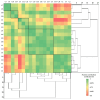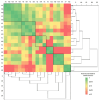Heavy Metals and Associated Risks of Wild Edible Mushrooms Consumption: Transfer Factor, Carcinogenic Risk, and Health Risk Index
- PMID: 39728340
- PMCID: PMC11676395
- DOI: 10.3390/jof10120844
Heavy Metals and Associated Risks of Wild Edible Mushrooms Consumption: Transfer Factor, Carcinogenic Risk, and Health Risk Index
Abstract
This research aims to investigate the heavy metals (i.e., Cd, Cr, Cu, Ni, and Pb) in the fruiting bodies of six indigenous wild edible mushrooms including Agaricus bisporus, Agaricus campestris, Armillaria mellea, Boletus edulis, Macrolepiota excoriate, and Macrolepiota procera, correlated with various factors, such as the growth substrate, the sampling site, the species and the morphological part (i.e., cap and stipe), and their possible toxicological implications. Heavy metal concentrations in mushroom (228 samples) and soil (114 samples) were determined by Inductively Coupled Plasma-Mass Spectrometry (ICP-MS). In the first part of the study, the soil contamination (index of geo-accumulation, contamination factor, and pollution loading index) and associated risks (chronic daily dose for three exposure pathways-ingestion, dermal, and inhalation; hazard quotient of non-cancer risks and the carcinogenic risks) were calculated, while the phytoremediation capacity of the mushrooms was determined. At the end of these investigations, it was concluded that M. procera accumulates more Cd and Cr (32.528% and 57.906%, respectively), M. excoriata accumulates Cu (24.802%), B. edulis accumulates Ni (22.694%), and A. mellea accumulates Pb (18.574%), in relation to the underlying soils. There were statistically significant differences between the stipe and cap (i.e., in the cap subsamples of M. procera, the accumulation factor for Cd was five times higher than in the stipe subsamples). The daily intake of toxic metals related to the consumption of these mushrooms with negative consequences on human health, especially for children (1.5 times higher than for adults), was determined as well.
Keywords: Bucegi National Reservation; carcinogenic risk; daily intake metals; estimated daily intake; health risk index; industrial area; touristic area; transfer factor; wild edible mushrooms.
Conflict of interest statement
The authors declare no conflicts of interest.
Figures







Similar articles
-
Heavy metal bioaccumulation by wild edible saprophytic and ectomycorrhizal mushrooms.Environ Sci Pollut Res Int. 2016 Sep;23(18):18239-52. doi: 10.1007/s11356-016-7027-0. Epub 2016 Jun 7. Environ Sci Pollut Res Int. 2016. PMID: 27272918
-
Metal accumulation capacity of parasol mushroom (Macrolepiota procera) from Rasina region (Serbia).Environ Sci Pollut Res Int. 2016 Jul;23(13):13178-90. doi: 10.1007/s11356-016-6486-7. Epub 2016 Mar 29. Environ Sci Pollut Res Int. 2016. PMID: 27023804
-
Contamination of wild-grown edible mushrooms by heavy metals in a former mercury-mining area.J Environ Sci Health B. 2014;49(11):815-27. doi: 10.1080/03601234.2014.938550. J Environ Sci Health B. 2014. PMID: 25190556
-
Pollution status and human health risk assessments of selected heavy metals in urban dust of 16 cities in Iran.Environ Sci Pollut Res Int. 2020 Jun;27(18):23094-23107. doi: 10.1007/s11356-020-08585-8. Epub 2020 Apr 24. Environ Sci Pollut Res Int. 2020. PMID: 32329009 Review.
-
Selenium in edible mushrooms.J Environ Sci Health C Environ Carcinog Ecotoxicol Rev. 2008 Jul-Sep;26(3):256-99. doi: 10.1080/10590500802350086. J Environ Sci Health C Environ Carcinog Ecotoxicol Rev. 2008. PMID: 18781538 Review.
Cited by
-
Radioactive Contaminants in Edible Mushrooms: A Comparative Study of 137Cs and Natural Radionuclides in Amasya and Tekirdağ, Türkiye.J Fungi (Basel). 2025 May 1;11(5):351. doi: 10.3390/jof11050351. J Fungi (Basel). 2025. PMID: 40422685 Free PMC article.
-
Potential Health Risk of Microplastic Exposures from Skin-Cleansing Products.Toxics. 2025 Apr 29;13(5):354. doi: 10.3390/toxics13050354. Toxics. 2025. PMID: 40423433 Free PMC article.
-
Linking soil properties to elemental uptake patterns: species-specific accumulation in Boletales mushrooms.Environ Geochem Health. 2025 May 28;47(6):236. doi: 10.1007/s10653-025-02546-1. Environ Geochem Health. 2025. PMID: 40437321 Free PMC article.
-
MiR5651, miR170-3p, and miR171a-3p Regulate Cadmium Tolerance by Targeting MSH2 in Arabidopsis thaliana.Plants (Basel). 2025 Jul 2;14(13):2028. doi: 10.3390/plants14132028. Plants (Basel). 2025. PMID: 40648037 Free PMC article.
-
Nutritional and Therapeutic Potential of Stropharia rugosoannulata and Macrolepiota procera: From Composition to Health-Promoting Effect.J Fungi (Basel). 2025 Mar 27;11(4):259. doi: 10.3390/jof11040259. J Fungi (Basel). 2025. PMID: 40278080 Free PMC article. Review.
References
-
- Wasser S. Medicinal mushrooms as a source of antitumor and immunomodulating polysaccharides. Appl. Microbiol. Biotechnol. 2002;60:258–274. - PubMed
-
- Nowakowski P., Markiewicz-Zukowska R., Gromkowska-Kępka K., Naliwajko S.K., Moskwa J., Bielecka J., Socha K. Mushrooms as potential therapeutic agents in the treatment of cancer: Evaluation of anti-glioma effects of Coprinus comatus, Cantharellus cibarius, Lycoperdon perlatum and Lactarius deliciosus extracts. Biomed. Pharmacother. 2021;133:111090. doi: 10.1016/j.biopha.2020.111090. - DOI - PubMed
Grants and funding
LinkOut - more resources
Full Text Sources
Miscellaneous

